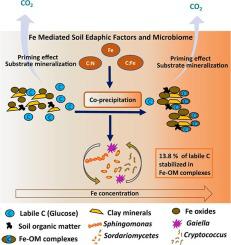Our official English website, www.x-mol.net, welcomes your feedback! (Note: you will need to create a separate account there.)
The stoichiometric C-Fe ratio regulates glucose mineralization and stabilization via microbial processes
Geoderma ( IF 6.1 ) Pub Date : 2021-02-01 , DOI: 10.1016/j.geoderma.2020.114769 Peduruhewa H. Jeewani , Lu Ling , Yingyi Fu , Lukas Van Zwieten , Zhenke Zhu , Tida Ge , Georg Guggenberger , Yu Luo , Jianming Xu
Geoderma ( IF 6.1 ) Pub Date : 2021-02-01 , DOI: 10.1016/j.geoderma.2020.114769 Peduruhewa H. Jeewani , Lu Ling , Yingyi Fu , Lukas Van Zwieten , Zhenke Zhu , Tida Ge , Georg Guggenberger , Yu Luo , Jianming Xu

|
Abstract The association of soil organic matter (SOM) with iron (Fe) oxides by adsorption and/or co-precipitation contributes to long term C stabilization in soil. While there is an understanding of the relationship between soil carbon (C) and the biogeochemical cycling of Fe, a lack of information exists on the role of Fe oxides on the accumulation of C in paddy soils. This study aimed to assess the role of Fe (oxyhydr)oxides on mineralization and stabilization processes following amendment of paddy soil with a labile C substrate (99 atom % 13C-glucose). The study utilized 4 paddy soils with a total Fe concentration ranging from 13.7 to 55.8 g kg−1. In soils with 42.7 and 55.8 g kg−1 Fe, the addition of glucose resulted in an Fe bound organic C: Fe molar ratio (C:Fe molar ratio) ≥6, suggesting the formation of Fe-OM complexes mainly via co-precipitation. The highest portion of 13C (13.8%) protected in Fe-OM complexes was found in soil containing 55.8 g kg−1 of Fe. The stabilization of the added labile C substrate was shown, using random forest analysis, to be controlled by the C: Fe molar ratio, while substrate mineralization was regulated by the core genera Sphingomonas and Devosa (r-strategists) (affiliated to Proteobacteria) and C:N ratio. Substrate mineralization was 47% lower in soil containing 55.8 g Fe kg−1 compared to 13.7 g Fe kg−1, with a concomitant reduction in SOM priming of 37%. This reduction in substrate mineralization and the priming effect was likely due to lower C substrate availability via the formation of Fe-OM complexes, thereby protecting the C from mineralization. In conclusion, the Fe concentration in paddy soils plays a central role in the abiotic stabilization of ‘new’ C through the formation of Fe-OM complexes via co-precipitation, thereby limiting the availability of this C substrate for microbial mineralization, and at the same time modulating the microbial community structure.
中文翻译:

化学计量的 C-Fe 比通过微生物过程调节葡萄糖矿化和稳定
摘要 土壤有机质 (SOM) 与铁 (Fe) 氧化物通过吸附和/或共沉淀的结合有助于土壤中的长期 C 稳定。虽然对土壤碳 (C) 与铁的生物地球化学循环之间的关系有所了解,但缺乏关于铁氧化物对水稻土中碳积累的作用的信息。本研究旨在评估 Fe(羟基)氧化物在用不稳定的 C 底物(99 原子% 13C-葡萄糖)改良稻田后的矿化和稳定过程中的作用。该研究使用了 4 种稻田,总铁浓度范围为 13.7 至 55.8 g kg-1。在 42.7 和 55.8 g kg−1 Fe 的土壤中,添加葡萄糖导致 Fe 结合有机 C:Fe 摩尔比(C:Fe 摩尔比)≥6,表明主要通过共沉淀形成 Fe-OM 复合物。在 Fe-OM 复合物中保护的 13C 的最高部分 (13.8%) 在含有 55.8 g kg-1 Fe 的土壤中被发现。使用随机森林分析显示,添加的不稳定 C 底物的稳定性受 C: Fe 摩尔比控制,而底物矿化受核心属鞘氨醇单胞菌和 Devosa(r-策略家)(附属于变形杆菌)和C:N 比率。与 13.7 g Fe kg-1 相比,在含有 55.8 g Fe kg-1 的土壤中,基质矿化降低了 47%,同时 SOM 引发降低了 37%。这种底物矿化和引发效应的减少可能是由于通过形成 Fe-OM 复合物降低了 C 底物的可用性,从而保护 C 免于矿化。综上所述,
更新日期:2021-02-01
中文翻译:

化学计量的 C-Fe 比通过微生物过程调节葡萄糖矿化和稳定
摘要 土壤有机质 (SOM) 与铁 (Fe) 氧化物通过吸附和/或共沉淀的结合有助于土壤中的长期 C 稳定。虽然对土壤碳 (C) 与铁的生物地球化学循环之间的关系有所了解,但缺乏关于铁氧化物对水稻土中碳积累的作用的信息。本研究旨在评估 Fe(羟基)氧化物在用不稳定的 C 底物(99 原子% 13C-葡萄糖)改良稻田后的矿化和稳定过程中的作用。该研究使用了 4 种稻田,总铁浓度范围为 13.7 至 55.8 g kg-1。在 42.7 和 55.8 g kg−1 Fe 的土壤中,添加葡萄糖导致 Fe 结合有机 C:Fe 摩尔比(C:Fe 摩尔比)≥6,表明主要通过共沉淀形成 Fe-OM 复合物。在 Fe-OM 复合物中保护的 13C 的最高部分 (13.8%) 在含有 55.8 g kg-1 Fe 的土壤中被发现。使用随机森林分析显示,添加的不稳定 C 底物的稳定性受 C: Fe 摩尔比控制,而底物矿化受核心属鞘氨醇单胞菌和 Devosa(r-策略家)(附属于变形杆菌)和C:N 比率。与 13.7 g Fe kg-1 相比,在含有 55.8 g Fe kg-1 的土壤中,基质矿化降低了 47%,同时 SOM 引发降低了 37%。这种底物矿化和引发效应的减少可能是由于通过形成 Fe-OM 复合物降低了 C 底物的可用性,从而保护 C 免于矿化。综上所述,


























 京公网安备 11010802027423号
京公网安备 11010802027423号